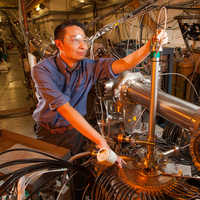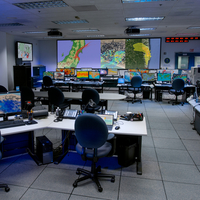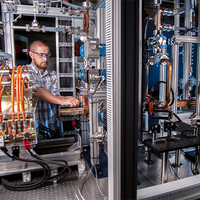OUR RESEARCH
Bioscience and Bioengineering
What We Do

Who We Are
Our bioscience experts — leading researchers in immunology, genomics, synthetic biology, biotechnology and biomaterials — partner with academia, industry and other institutions to foster innovation. Meet a few of the people who work in bioscience and bioengineering:

Feliza Bourguet was inspired to enter the field of molecular biology when she first learned about human genetics and the Punnett square, the diagram that indicates predicted genetic outcomes of offspring from cross breeding. Her interest in genes has not waned at all. Feliza’s day-to-day work at LLNL focuses on gene design for protein synthesis, expression, purification and analysis. Her research supports both the Physical and Life Sciences and Global Security Directorates at the Laboratory. “I’m particularly proud of my contributions on nanolipoprotein particle (NLP) projects, showing that NLPs can be used to characterize membrane-associated protein complexes and serve as scaffolds for component vaccines,” she says.
Feliza and fellow researchers received a patent for developing antibiotics to fight antibiotic-resistant bacteria, known as superbugs, by using a pathogen’s own genes against itself. More recently, she and Laboratory scientists have used antibodies from the early 2000s SARS-1 outbreak to engineer antibodies for the virus causing COVID-19.
Feliza has worked at LLNL since earning her M.S. in applied biosciences. “I enjoy working in a diverse scientific environment where people with a variety of backgrounds collaborate toward a common goal,” she says. “My colleagues are wonderful, and I love the work I do.” Outside the Laboratory, Feliza plays violin in the Livermore-Amador Symphony.
Feliza earned an M.S. in applied biosciences and a B.S. in molecular and cell biology from the University of Arizona.

Razi Haque is a research engineer and the Implantable Microsystems group leader at Lawrence Livermore National Laboratory where he serves as principal investigator for a number of externally-funded research programs from the NIH and DARPA as well as internally-funded Laboratory Directed Research Development programs. The Implantable Microsystems Group primarily focuses on building flexible devices using microfabrication techniques and tools and leverages a quality management system to build human-grade implantable devices. The Group’s research focus is on next-generation neural interfaces and integrating multi-modal capabilities, including chemical and optical interfaces. Previously, Razi worked at a startup in southern California focusing on translating his graduate studies at the University of Michigan which focused on an intraocular implantable microsystem.

A curiosity about how things work inspired Helgi Ingolfsson to look beyond the complexity of fields such as biology to discover, little by little, the underlying principles. Today, Helgi describes himself as a computer scientist turned experimental biophysicist turned computational biologist.
At LLNL, Helgi works to measure drug-induced changes in cell membrane properties — work of great importance as many of the key proteins that regulate cell function are membrane embedded, and their function can change when the membrane environment is altered. The membrane-mediated mechanism that can cause drugs to have undesirable, off-target effects on a range of proteins, even without directly interacting with them, can be tested in silico (computer-performed experimentation) during drug design, even before the drug lead is synthesized. That’s where Helgi’s expertise as a computational biologist enters the picture. Helgi develops computational models, writes codes to run simulations more effectively and runs and analyzes molecular dynamics simulations on some of the world’s largest high-performance computers. “I get to work on exciting, large-scale projects with a diverse group of experts,” he says.
Helgi earned a Ph.D. in computational biology and medicine from Weill Cornell Medical College, an M.S. in computer science from Cornell University and a B.S. in computer science from the University of Iceland, Reykjavik.

Crystal Jaing is working to predict and detect future pathogen outbreaks using advanced genomic technologies such as the Lawrence Livermore Microbial Detection Array (LLMDA). In fact, Crystal and her team developed the LLMDA technology, which provides the most comprehensive microbial detection for more than 12,000 species of microbes. The LLMDA won a R&D 100 award in 2017 and the Federal Laboratory Consortium Excellence in Technology Transfer award in 2019. Further applications of the LLMDA include drug safety, food safety, biodefense, public health and the analysis of microbes from the International Space Station — a NASA-funded project in which Crystal served as principal investigator to evaluate the potential for pathogenic microbes that could cause health problems for astronauts.
As a principal investigator for Global Security’s Biological Science and Security Program, Crystal actively manages and leads collaborations with academia, industry and government agencies to develop and apply genomics and pathogen detection technologies to solve problems in biosecurity, agricultural security, biosurveillance and public health.
Crystal holds a Ph.D. in molecular biology and biochemistry from the Indiana University School of Medicine and a B.S. in chemistry from Nankai University.

As a young person, Carlos Valdez excelled in art and soccer. But his first love was science. He says, “Science gave me a rational explanation for everything and a solution for every problem.” Today, Carlos is a synthetic chemist at the Laboratory’s Forensic Science Center (FSC).
Carlos serves on a specialized team to identify unknown chemical, biological, radiological, nuclear and explosive threat substances. Because FSC chemists work with real-world samples from around the globe — often from environments where groups of people may have been exposed to the substance — acting quickly and accurately has a significant impact on human lives. Carlos’s role is to synthesize a sufficient amount of the sample material so his colleagues can use it for analysis and identification tests. In addition, Carlos leads a multidisciplinary team of scientists who discovered the first nerve-agent antidote that can cross the blood-brain barrier. Before joining LLNL, Carlos’ scientific career included experience at Florida International University, the National Cancer Institute, the University of California Berkeley, the Scripps Research Institute and Rigel Pharmaceuticals.
Carlos holds a Ph.D. in organic chemistry from the University of California, Berkeley, and a B.S. in chemistry from Florida International University. He has been recognized at the lab with many awards, including the 2022 Global Security Directorate Spot Award, the 2021 Global Security Directorate Silver and Gold Awards, the 2020 Physical and Life Sciences Directorate Award and a 2019 LLNL Mid-Career Research Award.

Allison Yorita is a staff engineer in the Implantables Microsystems group, located within the Materials Engineering Division at Lawrence Livermore National Laboratory (LLNL). She joined LLNL in 2016 as a postdoctoral researcher, transitioning to staff engineer in 2019. Allison has led multiple projects as a principal investigator at LLNL, focused on flexible implantable arrays for detection of electrical and chemical signals in the body. With a background in chemical engineering, her research focus has been in creating novel chemical sensors for detection of a variety of biomolecules and chemicals at high spatial and temporal resolution. Leveraging LLNL’s work in fabricating high channel count, flexible microelectrode arrays, she aims to add additional sensing modalities to the array platform for better insight into the body’s microenvironment, with a focus on the central and peripheral nervous system.
Allison comes to LLNL from the University of California, Los Angeles, where she obtained her Ph.D. in chemical engineering in 2016. Her graduate work focused on microfabrication and development of silicon-based chemical sensors for detection of neurotransmitters, as well as development of a bioelectronic diagnostic tool for sensitive, selective detection of nucleic acid sequences from pathogens.
Our Latest News
Our Current Projects
We take on the entire life cycle of biological challenges — from awareness to prevention, preparedness to detection and response to recovery — to develop innovative solutions across a range of missions.

Sustainable Biomining of Rare Earth Elements
We are exploring environmentally friendly biomining techniques that can efficiently extract, purify and recycle rare-earth elements (REEs)—critical minerals that play an essential role in clean energy and defense technologies. LLNL scientists developed a protein-based biomaterial that enables REE extraction and separation from non-traditional feedstocks, such as end-of-life consumer electronics. They continue exploring ways to increase the technique’s efficiency, providing a sustainable, low-cost alternative to conventional, solvent-based REE separation methods.

Microbiome Research Takes Flight
We study microbial communities to understand how they influence human health. Our microbial analysis system evaluates the microbiome of combat wounds, identifying biomarkers that signal virulence pathogens or antibiotic-resistant organisms and providing key wound care information. We also collaborated with NASA to understand how space flight affects the human microbiome, using our high-throughput microbial detection system — now licensed by industry — to identify microorganisms in samples from International Space Station crews.

Biotechnology Aids Research in Brain Pathology
LLNL bioscientists and engineers continue honing brain-on-a-chip technology that allows human neurons to be cultured and their electrical activity monitored outside of the body. In combination with computational modeling of the activity and structure of neuronal communities, researchers use thin-film electrical arrays to understand how brain cells function, connect, and interact. Recently, researchers have made gains in data analysis, advancing the technology’s ability to help combat neurological impairments and illnesses such as Parkinson’s disease and epilepsy.
Our Facilities, Centers and Institutes
The Laboratory is home to several state-of-the-art facilities and centers to help researchers tackle the hardest and most complex biosecurity and bioscience challenges.
CBE
Center for Bioengineering
From discovery to design, the Center for Bioengineering (CBE) applies its tools and principles to complex biological systems. Our mission challenge is to enable transformational solutions to counter biological threats and increase national resilience.

FSC
Forensic Science Center
The Forensic Science Center (FSC) is home to nationally recognized scientists and capabilities to prepare for, characterize and respond to chemical, biological, radiological, nuclear and explosive threats.

Related Organizations
World-class science takes teamwork. Explore the organizations that contribute to our research in bioscience and bioengineering by clicking the images below.
Join Our Team
We offer opportunities in a variety of fields, not just science and technology. We are home to a diverse staff of professionals that includes administrators, researchers, creatives, supply chain staff, health services workers and more. Visit our careers page to learn more about the different career paths we offer and find the one that speaks to you. Make your mark on the world!








